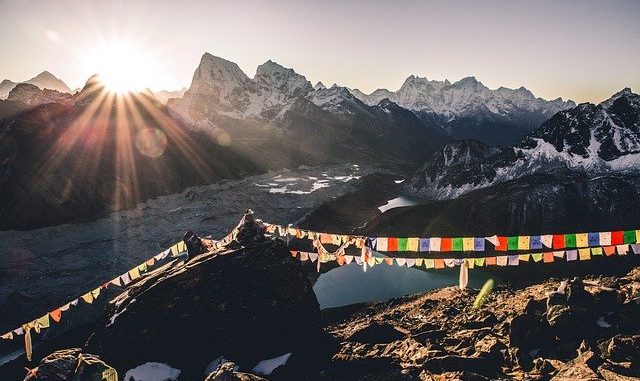
Nepal may seem as remote a country as any but it stretches its hand out to the world through its cuisine. Nepalese cuisine has so much to offer that it defies belief. It’s more than just a curry cooked by ghurkas, it brings with it flavours only experienced in the high Himalayas.
Considering that geography is key to how Nepalese cuisine developed, the Kathmandu Valley is probably the conduit through which ideas flowed into and out of the country. It calls upon Indian, Chinese, Tibetan and Thai cooking for its influences. A reflection of those tribes which have passed through these high passes. There is said to be even nods to European tastes stretching back over the centuries.
Most ingredients are found now in specific Indian and even Chinese shops. Part of this cross-over comes from the fact that the country is a bridge between these giant states.
The Nepalese are very rigorous in their eating habits. Only the right hand is ever used. All is served most often on a simple metal plate called the ‘Thal‘ which has particular sections for various items. A curry is not eaten in its own right from a bowl but poured into the plate. Any chunks are separated by the fingers and all still using the right hand as the utensil of choice. Quite remarkable to watch!
We might think of snow in the high places but Nepal receives plenty of sun and solar drying is the specific approach to drying foods to achieve some stability.
The staples for the Nepalese are corn and rice, millet, wheat and plenty of beans and other legumes. Expect plenty of ginger, garlic and onion. There is also a stunning range of chutneys to bring a piquancy and bite to all the dishes when they merit it.
Rice is often served in many forms but to improve its digestability is usually pounded to form a type of rough paste that acts as a base for curry to sit on.
One of the staple dishes is dal bhat. This is a rice dish that is joined with a classic vegetable curry or one of meat and lentil soup. It is probably their favourite of all and provides much of the nutrition needed being very filling.
Meat Dishes In Nepalese Cuisine
Look out for choila which is a specialist meat dish of the Newari people. It is grilled meat prepared from chicken with buffalo and mutton. Typically it must be heavily spiced using red and green chilis and topped up with musty top notes of fenugreek seeds and turmeric.
The countryside is harsh because it is so mountainous. It relies then on a lot of fermented foods to extend the season and maintain some of the freshness without destroying the flavour. Even the bamboo shoots called tama and the leafy greens known as gundruk lend themselves well to this approach as they create some unique textures.
A meal might start with some patties called bara or bada made from black lentils to which is added the spiciness of ginger paste coupled to a warm musky heat of cumin which seems to encourage the feeling that both ingredients travelled up the mountains from opposite sides of the range.
A more fulsome dish is a kwati which is a traditional stew of legumes including various peas, soya beans, kidney beans and black-eyed peas. It too is flavoured with turmeric giving it a deep red brick colour and heavily flavoured with ajwain lovage seeds
A much more familiar starter to Western eyes is the samosa. This too has a Nepalese feel using the same spicy notes of ginger running through the dish. All are deep fried. The meat versions usually rely on lamb but there is goat even if this is not as common as is expected.
Of the spices, chilli along with black cumin seeds, lovage, curry powder are prevalent. We’ve already covered ginger but an alternative is tamarind.
These spices are used extensively to juice up dishes like momos. These are small envelopes of white flour which are very similar to dumplings but contain meats like chicken, goat or minced lamb. There is a vast range of sauces to choose from and these will often sit in a sauce like broth topped with chopped coriander (cilantro).
Dairy Foods In Nepalese Cuisine
The yak and buffalo are herd animals which are kept for their rich dairy milk. This too is fermented extensively to produce very thick yogurts and curds. The ‘king curd’ called Juju Dhau is produced from buffalo milk and is heavily sweetened to make a dessert. Some of these fermented foods are served like pongal but are not cooked as extensively.
Desserts
As with the Chinese, dumplings are a speciality and definitely one for the sweetest of teeth. Steamed dumplings called Yomari or Yamari are prepared with rice and filled with dates and citrus in a paste. Most of the sweetness comes from molasses sugar but there is an earthiness from sesame seeds. One particular filling is chaku. These dumplings are unique to the Newar community of Nepal and are a critical feature of the Yomari Punhi festivals.
Beverages
Tibetan Hot Beer is probably only found in Nepal and drunk from large wooden vessels through straws of bamboo. The base wort is millet and very little else save for some local pitching yeast.
In all there is much to recommend a trip to this fine country. Nepalese cuisine needs to be on that itinerary.
Having just come back from base camp 1 and travelled then into Katmandhu, I honestly think this could be where the next innovation comes from. Really enjoyed the curry fusion with Chinese food. Just delicious!